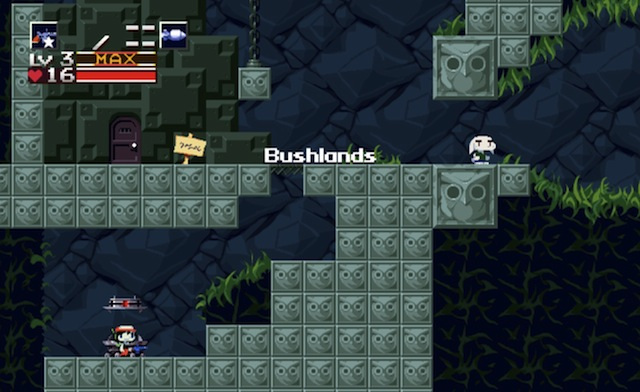Cave Story: The zig-zag world

Last week, I promised that this week’s post would be about narrative in Cave Story, but I’m going to put that off a bit, in part because the game is doing a great job of doling out the story bit by bit in ways that are keeping me interested as a player, and making me feel that I’m not really going to be able to say anything substantial until I can talk about the beginning, middle, and the end all at once. Right now, I know that I’m a robot left over from a war 10 years ago in which people attacked an island and its Mimiga inhabitants. Backed into a corner, the Mimiga ate certain red flowers, and became vicious fighting machines. Now, there are few Mimiga and fewer robots, an evil doctor who wants to exploit the Mimiga, and a good professor who wants to stop him. The whys and wherefores are still up in the air, but it’s becoming clear that everyone knows everyone else. Well, except for me, that is.
So instead I’d like to continue to talk about the ways in which the game mixes RPG and 2D platformer mechanics — primarily how a strikingly simple design choice serves to open up what would otherwise be a fairly linear world. In the 8-bit platforming world which is my (admittedly outdated) primary point of reference, games largely ask the player to navigate in one direction, often from left to right. The basic model would be, of course, Super Mario Bros., which doesn’t even let you backtrack once the screen has scrolled to the right, but even when games like Castlevania include vertical and right-to-left elements in their level design, there’s usually a specific forward direction at any given time, and it’s rare for a game to ask you to retrace your steps.
This might be one of the most brilliant components of the 2D platform game — particularly in systems with severe technical limitations (like an 8-bit console), the 2D platform game architecture creates a perpetual feeling of active progress. The game, when played, is in constant motion, and that motion is always directed toward a specific end. Thus, as long as the player is in motion, they can be confident that they’ll eventually reach the goal. The game may include rewards for exploration — hidden power-ups, warp zones, or bonus areas — but even a new player can just keep moving forward and progress through the game.
Cave Story, on the other hand, pushes the player back and forth within a level like no other 2D platformer I’ve ever played. I’ve created a map below of the path I followed to complete the Bushlands level (known in some versions of the game as the Grasslands). [Click on the map for a larger version.]
You’ll note that in addition to all of the smaller back-and-forths, the game requires the player to return to the very beginning of the level at least three times. While the level largely follows a progressive back-and-forth — that is, you could basically divide the level in half, and the player is required to thoroughly explore the first half, and then can largely move on to thoroughly explore the second half — but then the game violates this neat division when it makes the player return to the beginning to fetch charcoal as a bomb component.
The effect of all this, at least in my play, was to make the area much more of a map (in RPG terms) than a level (in 2D platformer terms). Rather than simply being able to progress (and then return to the teleporter after completing the level), I had to continue to re-explore, and continue to converse with non-player characters (NPCs), just like returning to a town after defeating a major monster, accomplishing a specific goal, or acquiring new items in an RPG. In fact, the player’s relationships with NPCs in Cave Story are more dynamic than in many 40-hour RPGs I’ve played.
And, in all honesty, Final Fantasy XIII could learn a thing or two from Cave Story‘s level design. (Too often, running around in Final Fantasy XIII is like Super Mario Bros. without the jumping. Ugh.)
So, story next week, I promise, and I’m hoping to look back on how the robot works as a blank slate/player identification character compared to Ness from EarthBound. (My initial take is that the robot works a lot better, but I need to do some noodling as to why and how.)
Thus far, we know that Daniel is enthusiastic about Cave Story‘s power-ups, and Kevin is a bit skeptical about the jumping mechanics (which is a pretty big problem for a platformer). I’m curious to know, though, on the whole how is the game working for the two of you? What genre would you cram it into? What, as you head towards the end, would it take to make or break the game for you?
I can’t believe that we wrap up next week! Well, onward! (And maybe back again.)
—
Read Daniel J. Hogan’s week 2 post
Read Kevin Nguyen’s week 2 post
—
Gavin Craig is co-editor of The Idler. You can follow him on Twitter at @craiggav.

Comments
2 Responses to “Cave Story: The zig-zag world”Trackbacks
Check out what others are saying...[…] have to admit that I am way behind Daniel and Gavin in my playthrough of Cave Story because I have been clocking a lot of hours into Diablo III, which […]
[…] motivations are complex, and often end up having unintended consequences. (Kind of like the physical navigation, the story has you double back, and double back again.) That, to me, is pretty close to the […]